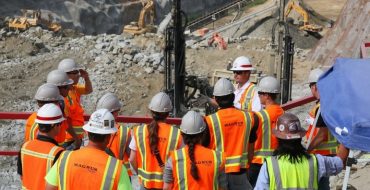
7 fundamentals of a no-nonsense toolbox talk *Construction Dive
Read the original article here
Communication regarding safety and health on any construction site is critically important. This goes for any workplace where there are significant hazards and risks. Employees need to be constantly trained on what is needed to be safe and healthy on any worksite. Toolbox talks can be immensely helpful in ensuring that all-important communication occurs.
But like any form of training, it needs to be done correctly. There are some tips worth noting when conducting toolbox talks, some of which are too often overlooked.
Keep it simple: A toolbox talk should be as simple and straightforward as possible. Don’t complicate it with multiple topics or issues that may confuse or bore attendees. Make it a short presentation to the workforce, on a single aspect of health and safety. Pick one topic and make that the sole theme for the entire talk.
Keep it short: A toolbox talk should be short and snappy. Productivity is key on any construction site, where workloads are heavy, project management schedules are invariably tight and deadlines are even tighter. A talk should feel like a snippet of the day has been spent on it. With this in mind, keep toolbox talks 10-15 minutes in length, even shorter if possible.
Keep it relevant: Whenever possible, ensure that the toolbox talk is linked to the main tasks/jobs being undertaken on the day of the talk. For example, if scaffolding work commences that day, then a talk focused on applicable work at-height procedures will be timely and — more importantly — have maximum impact on attendees.
Keep it outcome-based: A toolbox talk is not a nice chat around the fireside; it should have purpose and an express intent. As you ideally have a single topic for a toolbox talk, you can have one outcome if needed. Multiple outcomes can also work fine, as long as they are focused and remain on topic.
Before beginning, ask yourself a simple question about the toolbox talk: “What is this talk trying to achieve?”
Keep it about safety and health: This is one of those things that is too often overlooked in construction site toolbox tools: too much emphasis on safety only. This is understandable, given how hazardous most construction sites are. However, worker health is important, and conscious effort must be made to cover occupational health topics regularly. Ensure that health is not a poor cousin to safety.
Try to alternate talks about safety with talks about health on a one to one basis and don’t forget mental health. During the COVID-19 pandemic, four in ten adults in the U.S. reported symptoms of anxiety or depressive disorder. Just to compare, in 2019 that was the case for 1 in every 10 adults.
Choose a good location: Hold the talk away from noise and distraction and make sure everyone can hear you. Tasteful humor is OK, but don’t trivialize serious issues on site. Take attendance as workers report for the talk.
Make it visual: As the saying goes, “a picture tells a thousand words,” which is why visual media should be used during toolbox talks whenever possible and where it adds value.
Toolbox talks should instill pride and a collective sense of purpose in your company’s safety and health system, policies and procedures. Ultimately, your toolbox talks should actively promote a proactive safety and health culture. Keep that in mind with every talk conducted.